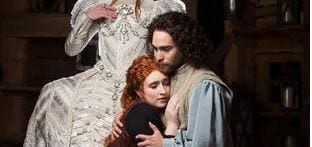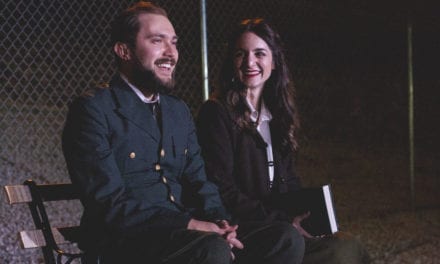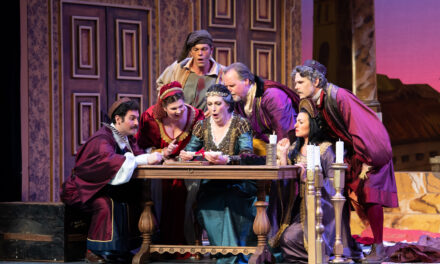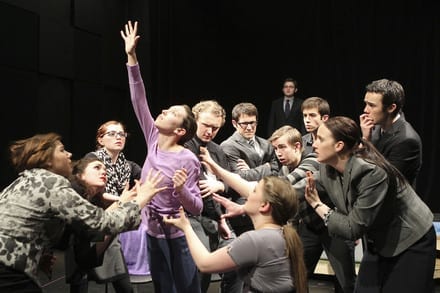WEST VALLEY CITY — A woman ahead of her time, Grace O’Malley is her own woman. Whereas other women in 16th century Ireland are expected to keep house and care for their families, Grace sails the seas and swordfights. With her iron will, she even dares to fight against the invading English and their queen, Elizabeth I. On stage now at the Hale Centre Theatre in West Valley, The Pirate Queen tells the story of this remarkable woman who deserves more attention from history.

Show closes April 2, 2016.
Heather McDonald plays Grace O’Malley with the strength and vocal agility that the role requires. McDonald managed to blend the rustic life of Grace’s Irish clan with the dignity of a noblewoman. McDonald started with a strong scene in “My Grace,” in which she pleaded with her father to let her sail the sea. In this song McDonald captured Grace’s longing for something better in life. McDonald’s duets with Jacob Theo Squire (in the role of Tiernan) were sweet, and both performers were adept at bringing emotion to “If I Said I Loved You” and “Here on This Night.”
Squire played Grace’s love, Tiernan. Squire created a feeling of affection with McDonald that made me enjoy their time on stage together, especially in their duets. Squire has remarkably strong vocal support, which made songs like “I’ll Be There” and “Surrender” seem effortless for him. Additionally, he gave Tiernan a cavalier demeanor that was well-matched with Grace’s fiery Irish spirit.

Brianna Gray as Queen Elizabeth, left, Heather McDonald as Grace O’Malley and Jacob Theo Squire as Tiernan.
Keith McKay Evans provided another noteworthy performance as Donal O’Flaherty, Grace’s husband, whom she marries to seal a political alliance with another clan. Evans clearly showed Donal’s vices (especially in “Boys’ll Be Boys” and “Let a Father Stand By His Son”) and why there was so much conflict between Donal and Grace. Yet, Evans wisely ensures that Donal never seems like a sleazbag, and I never begrudged spending time with the character.
Director David Tinney‘s work was flawless in every scene, and I could not find a single misstep within the entire play. Tinney has a talent for pageantry, which comes in handy in The Pirate Queen. Whether it was a funeral, a wedding, an Irish clan meeting, or the English court, Tinney created visually entrancing ceremonies on stage. Tinney’s choreography was also a highlight of the production. The boisterous “Boys’ll Be Boys” and Grace’s wedding to Donal were excellent blends of Irish dancing with traditional musical theatre choreography.
Of course, the technical elements of The Pirate Queen were at the superb level that audience members expect from the West Valley Hale. But the technical aspects of this production far surpass almost anything I have seen on the Hale stage. The costume designs (by Martin Pakledinaz and Tamara Clayton Baker) were true to the Renaissance time period. The Irish costumes conveyed the characters’ hardscrabble life and seemed like practical work clothes that someone in the era would wear. The English costumes were more opulent, and they communicated the cosmopolitan flair of Queen Elizabeth I’s court. Kacey Udy‘s set design was not as complicated as many Hale sets, but it always reinforced the story, especially in the first act finale, where the dozens of candles provided the somber atmosphere that the scene required. Adam Flitton‘s lighting design was another strength of the stagecraft of The Pirate Queen. Regardless of a scene’s location (e.g., outdoors, the bowels of a ship, or a palace), Flitton provide the right amount of illumination and color to make it supremely easy to suspend my disbelief and forget that I was in a theater.
Despite all of these strong points, The Pirate Queen had some insurmountable problems. Alain Boublil, Claude-Michel Schönberg, and Richard Maltby, Jr.‘s script fails to ever give the audience a reason to care about Grace’s life. The librettists vaguely convey a respect for Grace, but it is never clear what Grace’s story provides that sets it apart from Joan of Arc, Boudica, or other similar women in history. Moreover, it is never clear what audience members should learn about Grace O’Malley or the message they should take from the story. And the librettists never clearly show why Grace’s story should be musicalized. These issues so perplexed me that I could not figure out why anyone would want to produce this play, except perhaps for bragging rights of doing the first production in Utah or being able to advertise it as “from the creators of Les Misérables.”
Having been written by the creators of Les Misérables, Boublil and Schönberg’s most famous musical casts a long shadow over The Pirate Queen. Schönberg’s music—especially in the first act—sounds strongly reminiscent of Les Mis and the lyrics (by Boublil, Maltby, and John Dempsey) convey many of the same general feelings. Unfortunately, The Pirate Queen parrots the worst aspects of Les Mis, such as the bombastic, operatic solos (mostly assigned to Tiernan and Elizabeth I), meandering recitatives (especially for Dubhdara), and a penchant for maudlin sentimentality, without also providing the heart at the core of the superhit. Perhaps it is unfair to compare any show to the most popular musical ever written, but The Pirate Queen is about 85-90% sung-through and has much more stylistically in common with the big European musicals of the 1980’s than almost anything written in the 21st century. I challenge any musical theatre fan to sit through The Pirate Queen without thinking of Les Mis multiple times during the course of the performance; the similarities between the two shows are unmistakable.
In sum, the West Valley Hale has a great production of a terrible play. The efforts of every person involved in The Pirate Queen were O’Malley-like in their heroism. But they could not save the show from the plodding script and frequently tuneless score. The show is not without redeeming qualities, and I think that The Pirate Queen will find value in the eyes of season ticket holders at the West Valley Hale, some Les Mis fans, and readers who can appreciate the fine artistic and technical work of Utah theatre artists.





